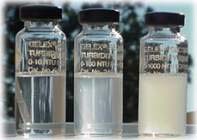
Back عكورة Arabic Terbolesa Catalan Kalnost Czech Trübung German Turbidez Spanish Sogasus Estonian کدورت Persian Sameus Finnish Turbidité French Ruwan Turbidity Hausa

| Part of a series on |
| Pollution |
|---|
 |
Turbidity is the cloudiness or haziness of a fluid caused by large numbers of individual particles that are generally invisible to the naked eye, similar to smoke in air. The measurement of turbidity is a key test of both water clarity and water quality.
Fluids can contain suspended solid matter consisting of particles of many different sizes. While some suspended material will be large enough and heavy enough to settle rapidly to the bottom of the container if a liquid sample is left to stand (the settable solids), very small particles will settle only very slowly or not at all if the sample is regularly agitated or the particles are colloidal. These small solid particles cause the liquid to appear turbid.
Turbidity (or haze) is also applied to transparent solids such as glass or plastic. In plastic production, haze is defined as the percentage of light that is deflected more than 2.5° from the incoming light direction.[1]
- ^ Thermallaminatingfilms.com. Haze technical definition Archived August 22, 2015, at the Wayback Machine